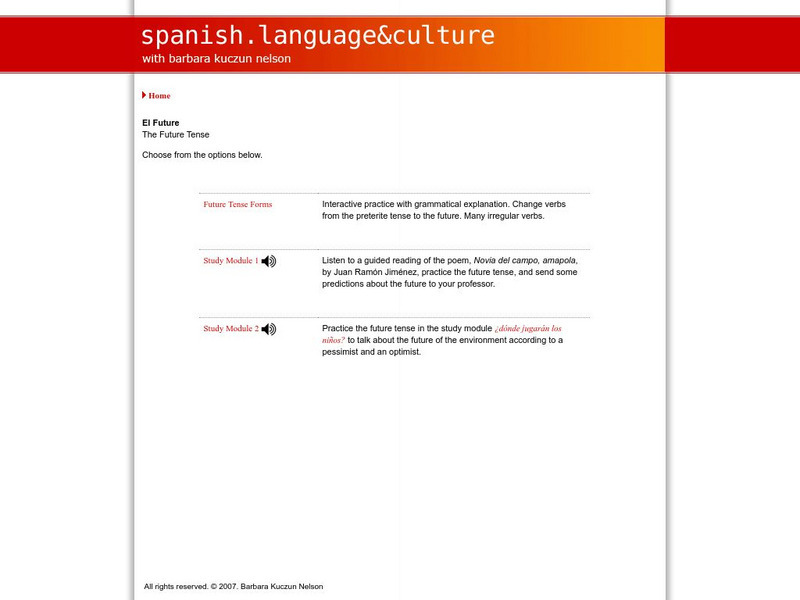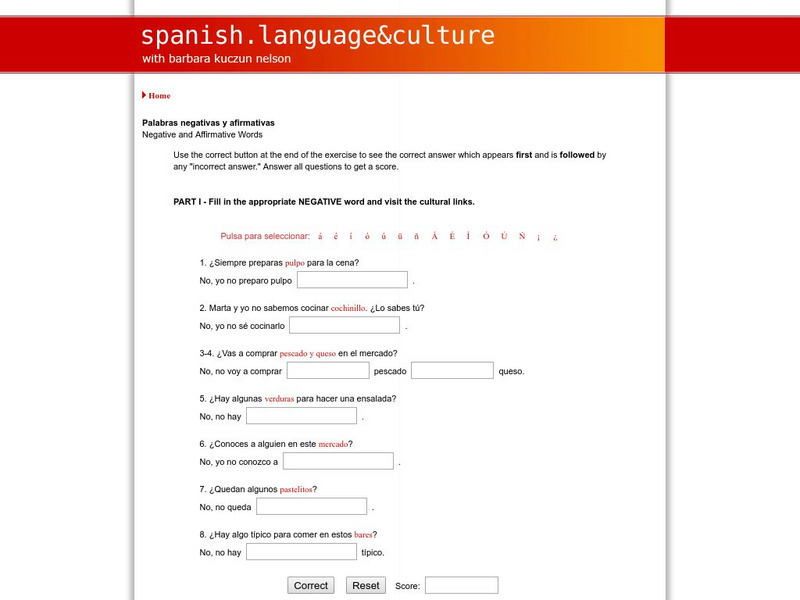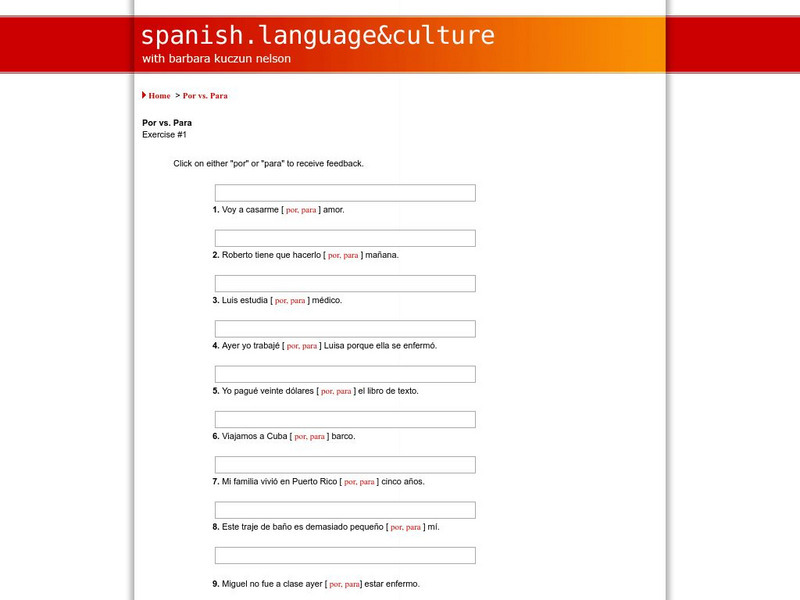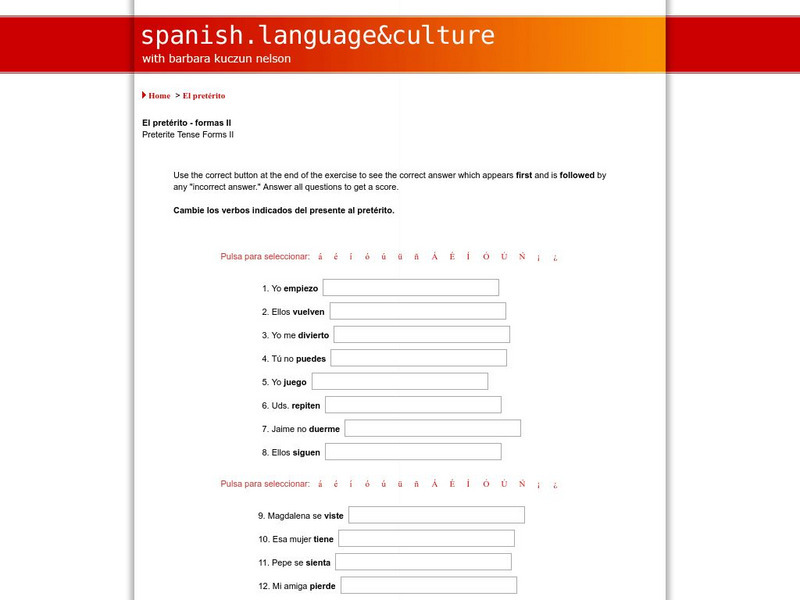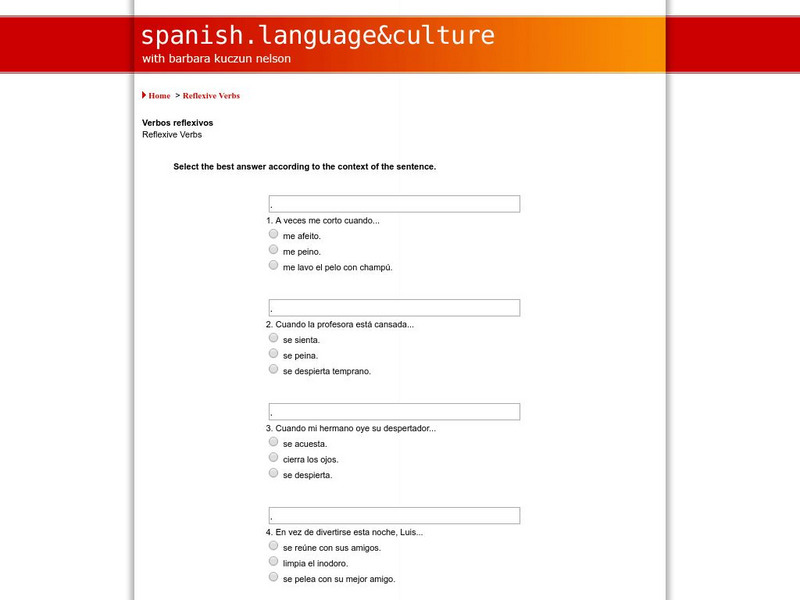Colby College
Spanish Language & Culture: Direct and Indirect Pronouns (Part 3)
This online exercise from the Colby College for practicing the substitution of pronouns for the direct object of a sentence, and for using the direct and indirect object pronouns together in the same sentence. A brief English...
Colby College
Spanish Language & Culture: Direct Object Pronouns (Part 2)
This online exercise is from Colby College for practicing direct object pronouns and the present indicative tense. A brief English explanation of a direct object pronoun introduces the lesson.Students follow an English translation to...
Colby College
Spanish Language & Culture: The Future Tense
Colby College provides a great explanation of how to conjugate verbs in the future tense, with English translations of the examples. Twenty sentences provide fantastic practice in changing verbs from preterite tense to future tense...
Colby College
Spanish Language & Culture: The Future of the Environment
Colby College offers exercises on the future of the environment from the perspectives of an optimist and of a pessimist provide great practice with the future tense.
Colby College
Spanish Language & Culture: Negative and Affirmative Words
Colby College offers a fill in the blank exercise that gives the user practice in determining which negative or affirmative word to use. Photos of new food vocabulary words are also accessible by clicking on the underlined word.
Colby College
Spanish Language & Culture: Rules for Numbers
Brief, useful explanation on how to use Spanish numbers.
Colby College
Spanish Language & Culture: #2 "Por" or "Para"
Choose "por" or "para" to complete each sentence. Pass the cursor over the highlighted preposition to check your answer and to get an explanation of its use.
Colby College
Spanish Language & Culture: The Present Perfect Tense
Review examples and then complete three online exercises dealing with the present perfect tense. English translations are provided for some of the examples. The first exercise provides verb infinitives as cues for the present perfect...
Colby College
Spanish Language & Culture: El Preterito Formas (Part 2)
These exercises review irregular verbs, stem-changers, and spelling changes in the preterite tense. Conjugate verbs to match the subject. Answers may be checked and corrected.
Colby College
Spanish Language & Culture: The Present Progressive Tense
Comprehensive online practice from Colby College is available for the present progressive tense. Regular, irregular, and stem-changing participles are included in this exercise. Utilize this self-grading online worksheet to help improve...
Colby College
Spanish Language & Culture: Spanish Reflexive Verbs Exercises
This site is great practice from Colby College with some of the more common reflexive verbs. This exercise is not as concerned with testing grammatical applications as it is with testing for the meaning of the reflexive verb in context....
Colby College
Spanish Language & Culture: Reflexive Verbs in Song
Complete the lyrics of a song with a variety of reflexive constructions. A great way to review some basic reflexive verbs and become familiar with other reflexive verbs that are not so basic.
Colby College
Spanish Language & Culture: Si Clauses With the Imperfect
This site from the Colby College provides a great explanation of "if" clauses and the imperfect tense. The exercise provides great practice with the imperfect past. Answers may be checked and corrected.
Grammarly
Grammarly Handbook: Faulty Parallelism in Comparisons Using Than
This page focuses on correcting mistakes in parallel structure when using the word "than" in a comparison. It also covers how to correct the parallelism.
Grammarly
Grammarly Blog: Anymore vs. Any More
This page explains the use of "anymore" in informal writing, but in formal writing and anywhere else, "any more" is preferable. Examples are provided.
Grammarly
Grammarly Blog: Every Time
This page explains and provides the rules for use of the two-word compound "every time."
Grammarly
Grammarly Blog: Double Negatives: 3 Rules You Must Know
This page explains the 3 rules for double negatives: each subject-predicate construction should only have one negative form, a double negative is a non-standard sentence construction that uses two negative forms, and standard English is...
Grammarly
Grammarly Blog: Future Perfect Tense
This page explains what future perfect tense means and how it is formed.
Grammarly
Grammarly Blog: Geographical Use of Definite Article The
This page provides rules for when to use and not use the article "the."
Grammarly
Grammarly Blog: Everyone vs. Every One
This article provides the rules for the proper use of the words "everyone" and "every one" with examples.
Grammarly
Grammarly Blog: Comma Before Too
This page explains the use of commas to emphasize the word "too" in a sentence; the use of one, two, or no commas depend of the use of "too" and its placement in the sentence.
Grammarly
Grammarly Blog: Exclamation Mark
This page explains the uses of exclamation marks including when to use and not use them and provides examples.
Grammarly
Grammarly Blog: Each and Every
This page explains the proper use of the singular words "each" and "every" and provides examples.
University of Victoria (Canada)
University of Victoria: Grammar Topics
A large collection of concise explanations of various aspects of English grammar and usage. All topics include exercises that can be done, checked, and corrected online. Solid resource for English language learners at the intermediate...




